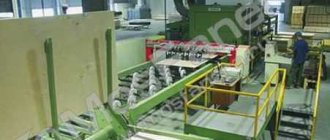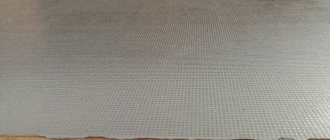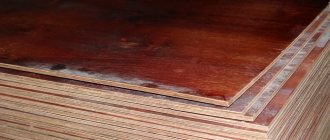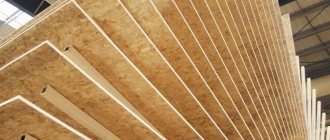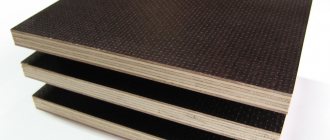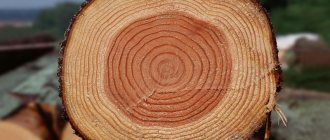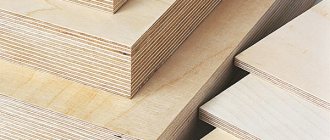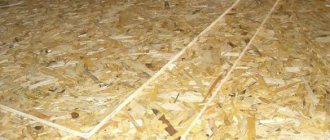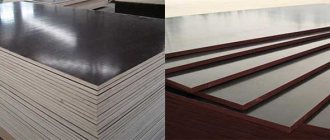Plywood is becoming increasingly popular both among professional builders and among people who decide to carry out repairs or start construction on their own. This is due to the versatility of this building material. After all, it can be used to make furniture of varying complexity and purpose, sheathe the walls of a frame house, level floors, and also build a boat.
Table of characteristics of different types of plywood.
The widespread use of plywood became possible due to its division into types according to technical characteristics. The most famous is FC plywood, the technical characteristics of which allow it to be used at any stage of construction.
Scope of plywood and its characteristics
Plywood is a sheet building material made from several thin layers of wood that are tightly glued together along their thickness (the so-called veneer). Typically, the fibers in adjacent layers of veneer are perpendicular to each other, which is why plywood is characterized by stability of shape and strength in different directions, which distinguishes it from ordinary wood. The most durable plywood is made from birch veneer. In addition, there are special types of plywood that have increased resistance to torsion and bending: they are glued together in such a way that the veneer fibers are located at an angle of 30°, 45° or 60° to adjacent layers or sheet edges. The number of layers in a plywood sheet is almost always odd: three, five, seven, nine or more, with the veneer placed symmetrically around the central layer, in which case the plywood is less susceptible to warping. But plywood is also produced from four layers: the wood fibers of the two central layers run parallel to each other, and the fibers of the outer layers are directed perpendicular to the inner ones. This perpendicular arrangement of adjacent layers achieves uniform tensile strength in all directions at once. Plywood sheets are most often assembled from layers of veneer, the material for which was one type of wood. For the production of furniture and doors, veneered joinery with decorative trim and cladding is often used.
The water resistance of plywood largely depends on the type of glue used to glue the layers of wood together.
Divisions and nuances
FC plywood is divided into grades:
Table of plywood grades.
- 1st grade. Plywood with this grade marking has an ideal surface on which to apply varnish. At the same time, defects in the top veneer along the length should not exceed 20 cm, and such defects as chipped edges, lack of veneer on one side of the sheet should not be more than 3 in number. And if they are present, the dimensions should be minimal.
- 2 varieties. This FC plywood has a slightly larger number of defects and possible production damage. Cracks no larger than 20 cm in size and the presence of inserts from other wood are allowed. Defects in the outer veneer layer, such as scratches and dents, should be no more than 5% of the total area of the plywood sheet. At the same time, the wood itself, from which veneer for grade 2 plywood is produced, may have knots of different colors and holes associated with their loss as a result of processing in production.
- 3 varieties. On such plywood, defects in the amount of 9 pieces are allowed, such as knots (fused, healthy), wormholes with a diameter of 6 mm. During production, glue can leak onto the edges or joints of veneer sheets by 5% of the total sheet area. The width of the edge defect associated with the lack of veneer should not exceed 20 cm, as well as the overlap.
- 4 varieties. This is plywood of the lowest quality production. The number of knots, both fallen and present, is not limited. In addition, the standards do not impose restrictions on wormholes whose diameter does not exceed 40 mm. Due to such low quality of grade 4 plywood, it is used for the production of containers and other rough construction work.
Table of properties of FC plywood.
In addition to dividing into grades, FC plywood can be divided according to the degree of treatment of the outer surface into unsanded, sanded on one side, sanded on both sides. This division is indicated in the sheet marking with the designations НШ, Ш1, Ш2, respectively. A description of all the characteristics of plywood must be included in the documentation available from the seller of this product. The buyer has the right to demand it.
The thickness of the plywood sheet ranges from 3 mm to 30 mm. This characteristic is determined by the number of glued layers of veneer. When producing plywood, an odd number of veneer sheets are glued together. That is, if the sheet thickness is 3 mm, then 3 layers of veneer were glued together to make it. 30 mm plywood consists of 21 layers and is the most durable.
When gluing, the wood fibers of the combined veneer sheets are located at the same angle, which ensures strength.
Dependence of durability on stress during transverse bending for FK plywood of various laminations.
The wood species of the central layer of plywood, onto which the veneer is subsequently glued, may differ from each other. But this does not in any way affect the characteristics of the plywood as a whole. If more than 2 sheets are used in the production of plywood, and their wood fibers are at right angles to each other, then the result will be facing plywood.
Most often, birch wood is used as a starting material for the production of FC plywood.
However, the use of coniferous species is acceptable. Plywood made from birch or pine can be distinguished by eye by the texture and color of the outer veneer.
Plywood grades depending on water resistance
FK grade plywood - gluing is done with urea resin. Designed for indoor use.
Plywood brand FSF (increased moisture resistance) - layers are glued together with phenolic resin. Can be used both indoors and outdoors.
FB grade plywood (bakelized plywood) - glued together after impregnation with bakelite varnish. Can be used in tropical climates, sea water and other types of aggressive environments.
FOF plywood (laminated plywood) is birch plywood lined on one or both sides with a film coating (paper impregnated with synthetic resin).
Additional points
In addition to the fact that FC plywood is less susceptible to the negative and destructive effects of moisture, it also has a number of advantages:
Dimensions of plywood boards.
- Plywood cannot crack through. This is due to the peculiarities of production, due to the fact that the veneer sheets are securely glued over the entire surface. And even if one of the layers is damaged or defective, a through crack cannot form.
- Good flexibility. Sheets of plywood can be bent into almost any shape. In this case, it is enough to make cuts along the sheet without damaging one of the outer layers, and bend the sheet. However, a large number of such cuts over the entire surface of the sheet slightly reduces its strength, but there is no doubt about the reliability of the resulting structure.
- Excellent transportability. FC plywood is quite easy to transport over considerable distances without fear of damage.
- Wide selection of plywood sheet sizes. Since plywood has significant overall dimensions, the main ones being 1220x2440 mm, 1250x2500 mm, 1525x1525 mm, construction work is greatly accelerated, for example, for lathing internal walls or covering the floor for further installation of laminate. These sizes of plywood allow you to make furniture elements of quite impressive sizes without extensions.
- Smooth surface on both sides of the plywood sheet with equal strength. This advantage allows the use of FC plywood not only in construction and repair work, but also in the production of furniture.
However, it is recommended to use FC plywood indoors. When used externally, it must be carefully protected from moisture.
Types of plywood by raw material composition
Birch. Used under increased loads when greater material strength is required. Waterproof FC is made from birch. Birch plywood owes its strength to the good physical characteristics of the wood itself and the multi-layer structure of the plywood. Due to its strength, it is widely used, for example, in the carriage industry, automotive industry and construction, that is, where the strength of the material is important, as well as for the production of packaging and containers. Another advantage of birch plywood is its external beauty (aesthetically pleasing wood structure and warm colors), which, combined with high-quality exterior finishing, has made such plywood a favorite material for exterior, interior and furniture making.
Coniferous. It is made of coniferous wood and is relatively light in weight. Such plywood is most often made from pine, the wood of which provides the plywood sheets with an attractive appearance and sufficient strength with low weight. Due to its advantages, it is often used in the construction of houses: in the construction of buildings for cladding walls, covering roofs, laying foundations for floors and constructing partitions. This plywood resists fungus and rot well, all thanks to impregnation with resins and gluing using phenol-formaldehyde glue. The attractive color and texture of wood have led to the spread of coniferous plywood in furniture production, where it is one of the most important materials, as well as in exterior and interior design. This plywood is used for roofing work; its service life is no less than that of a soft roof. During use, the dimensions of the coniferous plywood sheets change slightly: thickness changes by 0.03%, width and length by 0.02%.
Combined. This is the name of a plywood board, the veneer layers of which are made from different types of trees, which are located symmetrically with respect to the layer in the center. An example is Combi Twin plywood, in which the outer layers and inner layer are made of birch, while the inner layers are an alternation of birch and pine needles. “Combi” is when there is birch outside, birch and pine needles inside; “Twin” - birch makes up the outer layers of veneer, with only pine needles inside. Combined plywood looks beautiful and costs less than solid birch (the price is reduced by the use of layers of coniferous plywood, which is cheaper than birch), so it is widely used for making furniture and in interior decoration. Combined plywood combines the low cost of coniferous plywood and the strength of birch plywood, being only slightly inferior in strength to birch plywood.
Laminated. Laminated plywood is the most resistant to environmental conditions, both natural and chemical. Therefore, such plywood is very popular in the manufacture of wear-resistant surfaces, such as advertising billboards, ship decks, car and van linings, and concrete formwork forms. What adds to the popularity of laminated plywood is the ability to choose the type of surface (embossed or smooth) and the base for the laminate (birch or combined plywood). During production, laminated plywood is coated on both sides with a paper-resin film based on phenol-formaldehyde resin. This type of plywood is characterized by high density, resistance to wear and moisture. There is also large-format laminated plywood, the dimensions of which allow it to be used for the construction of large objects.
Main varieties
There are many signs by which plywood can be divided into classes and types. Among this gradation we can distinguish the following division:
Characteristics of thickness, number of sheets in the shell, volume and net weight of plywood in kg.
- by purpose (for construction work, for the manufacture of packaging, for industrial use);
- according to the wood material used, from which the veneer is made;
- by the number of gluing layers (from a small amount for packaging to thick plywood for walls and floors);
- by type of external treatment;
- by variety.
But the most common is the division into 2 large types: FK plywood, which is considered moisture resistant, and FSF, with increased moisture resistance characteristics. This division is caused by differences in the impregnation used in the production of plywood. Thus, FSF plywood is made using a special glue based on phenol-formaldehyde, which increases its resistance to moisture. This allows builders to use it in the construction of walls, floors, partitions of a frame house, and for production purposes. FC plywood is glued with carbide glue.
The use of this adhesive mixture for the production of plywood somewhat reduces the water-resistant characteristics of the plywood sheet, however, it is quite possible to use such plywood for interior decoration, furniture production, and also to make formwork for strip foundations.
In addition, FC plywood is divided into grades, which also affects its scope of application. At the same time, two types of veneers can be used on the same sheet of plywood, which saves money. The most common combinations are 1/1, 1/2, 3/4.
You may be interested in: Site about the foundation.
Plywood varieties
Grade I - practically no defects. Acceptable: unfused, partially fused and falling out knots and holes from them, wormholes no more than 6 mm in diameter and no more than 3 pieces per m2, no more than 5 large fused knots up to 15 mm in diameter per m2, medium-sized brown veins. It is not covered with anything or varnished. Laminated plywood is produced from this grade.
Grade II - acceptable: unfused, partially fused and falling out knots and holes from them, wormholes no more than 6 mm in diameter and no more than 6 pieces per m2, no more than 10 large fused knots up to 25 mm in diameter per m2, repair of the external one is possible parts of the leaf. Open defects must be sealed with veneer inserts. Covered with paints and finishing materials.
Grade III - acceptable: unfused, partially fused and falling out knots and holes from them, wormholes no more than 6 mm in diameter and no more than 10 pieces per m2, there is no limit on the number of large fused knots. It is used in the manufacture of structures that are not open to external view, as well as packaging materials and containers.
Grade IV - any manufacturing defects are acceptable: all types of knots, holes from under them, wormholes no more than 40 mm in diameter, good gluing is guaranteed. Designed for the production of durable packaging and containers.
Plywood marking
The main parameters of plywood are indicated in the designation with which it is marked. Standard marking contains:
- name of the material;
- the species from which the veneer of the outer layers is made;
- brand;
- variety;
- emission class;
- indication of surface grinding;
- sheet format;
- indication of the standard.
For example: “Pine plywood FSF 2/4 E1 Sh1 1525x1525x6.5 GOST 3916.2-96” is the designation of FSF pine plywood with surfaces of grades 2 and 4, first emission class, with one-sided sanding, thickness 6.5 mm, dimensions 1525x1525 mm, manufactured in accordance with GOST 3916.2-96.
For laminated plywood, the brand of film is additionally indicated. Marking bakelized plywood is easier. It includes only the name, brand, dimensions and reference to the standard.
For example: “FBS plywood 1500x1250x5 GOST 11539-2014.”
A Brief History of Plywood
The earliest historical examples of wooden plywood are known from the times of Ancient Egypt and date back to 3500 BC. They were made from sawn veneer and glued crosswise. In its properties, ancient Egyptian plywood differed little from modern ones.
A thousand years ago, plywood sheets were actively used in China for the production of furniture. In Europe, plywood began to be used much later: examples of furniture and wall panels are known in France and Great Britain. The earliest examples of European plywood were made from high-quality wood. Plywood was used to make cabinets, chests, countertops and doors.
Softwood plywood for use in construction work only appeared in the 20th century.
offers to buy plywood at the lowest prices.
Types of plywood
Today, factories produce products that differ in technological and design characteristics depending on the scope of application. It has a different internal structure, which determines its performance.
Types of plywood:
Characteristics of plywood
- Sanded and not sanded.
- Profiled plywood.
- General purpose.
- Bakelized.
- Laminated.
- Reinforced.
- Facing.
- Construction
- Aviation.
- Water resistant.
Depending on the quality of the veneer of the outer layer, plywood is divided into 5 grades: A/AB, AB/B, B/BB, BB/C, C/C.
Plywood production: from “A” to “Z”
With the development of monolithic construction, formwork systems have acquired particular importance. They are made from a metal frame and laminated plywood, which, due to its resistance to high loads, smooth surface and moisture resistance, can be reused many times.
Today we will talk about modern technology for the production of laminated plywood using the example of one of the leaders in this industry - the SVEZA group of plants.
Selection of raw materials
The production of laminated plywood is a complex multi-stage process, at each stage of which the accuracy of adherence to certain techniques is important.
The first stage consists of careful selection and preparation of raw materials. To produce plywood standard for Russia (1220x2440 mm), trunks with a diameter of 20-40 cm and a length of 5.2 m are processed (later they can be sawn into logs of 1.3 or 2.6 m, necessary for the production of longitudinal and transverse veneer of the required format ).
The main stage of preparation is boiling the raw materials. It is carried out in a special pool (open or closed) during the day. In summer, the temperature in the pool is kept at 35-40 °C, and in winter - 40-45 °C. To improve the quality of the veneer from which plywood will subsequently be made, it is important that at the welding stage the thermal conditions and time of wood processing are observed.
The boiled plywood logs are fed to the debarking and sawing department. Debarking is carried out as follows: the knives of the debarking machine cut the bark and remove it in strips in a spiral. In the future, it is used to heat the enterprise and neighboring buildings and even an entire village (as at the Perm plywood mill).
The debarked log is passed through a metal detector, which helps detect nails, wire debris and other metal elements stuck in the wood. Otherwise, there is a danger of damaging the equipment. A signal is sent to the machine control panel, the process stops, and the metal is removed by the operator. After debarking, the sawing process is carried out. The processed raw materials are sawn into logs to produce longitudinal and transverse veneer.
Making veneer
The next stage is peeling the veneer on special machines, where a continuous thin strip of veneer is cut from the prepared block. The thinner it is, the more layers there will be in the plywood and the stronger it will be.
Russian birch veneer is the thinnest (1.2-1.5 mm) compared to other types of wood (for example, the thickness of poplar veneer is 1.6-2.6 mm, and coniferous veneer is 2-4 mm).
At the peeling stage, quality control is mandatory. To do this, samples are taken every day to check thickness and a number of other parameters, and the results obtained are compared with standard ones. Taking this data into account, the peeling machines are adjusted. After peeling, the veneer strip is fed to automatic shears, where it is cut into format sheets measuring 1.3x2.6 m to produce plywood of 1220x2440 mm format. Longitudinal and transverse veneer (for subsequent gluing into one sheet of plywood) is produced on separate peeling lines.
Then the formatted veneer sheets go into the dryer. “In the dryer, the veneer sheets are blown with hot air. In 8-10 minutes, up to 90% of the moisture is removed from the wood. At the exit, the sheets are placed on a pallet or placed on a conveyor (depending on the design of the dryer),” says Natalya Andreeva, process engineer for the production of laminated plywood at the Fanplit plant, part of the SVEZA group.
Sorting, sorting, sorting...
After drying, the veneer is sorted according to a number of parameters, including the presence of fallen knots, cracks, etc. At many mills, automated equipment is used at this stage: the parameters of the grades are included in a computer program that controls the process. The surface is scanned and automatically assessed, after which the scanner itself controls the layout of the veneer in piles. The operator only observes the process. The moisture content of the sheets is assessed. If the veneer is under-dried, it is placed in a separate pile and dried later.
If defects are detected, the sheets are not disposed of, but are sent for repair, which can be carried out both on manual machines and on automatically controlled equipment. Automatic machines make it possible to improve the quality of plywood, reducing the cost of manual labor by 3 times. Now there is equipment for repairing veneer of any format: both standard - 5x5 feet (1525x1525 mm), and large - 5x10 feet (1500/1525x3000/3050 mm).
And at the end of this stage, the veneer is sorted again.
Picking plywood
To obtain finished plywood, you need to glue several sheets of veneer together. The fibers in successive layers are arranged perpendicular to each other, which gives strength to the finished product and resistance to deformation in any direction. This feature determines the applicability of plywood in formwork systems for monolithic construction.
When producing birch plywood, an odd number of veneer sheets with a thickness of 3 to 40 mm are glued together. Glue from chalk, water, resin and wood or rye flour is made here, in a special mixer. It is important to strictly adhere to the technology so that unsticking does not occur. For this purpose, modern enterprises have installed equipment that automatically controls the proportions of ingredients in accordance with the recipe.
The next stage is rolling. A sheet of veneer is passed between two rollers lubricated with glue, after which it is sent to the set.
“In the stack of the type-setting package, dry veneer and glue-coated veneer alternate. Their number depends on the thickness of the plywood. At the end of the picking process, the machine feeds 2 sheets of dry veneer (the last sheet of the previous “sandwich” and the first of the next), which will later allow you to separate one sheet of plywood from the other.
The stack prepared in this way is sent for pre-pressing,” comments Elena Vershinina, head of the quality service of the Perm plywood mill, part of the SVEZA group.
Cold pressing of bundles of collected veneer is carried out immediately before hot pressing in order to obtain solid bundles that are convenient for transportation and loading into a hot press. The cold pressing time is 5-10 minutes at a pressure of 1-1.5 MPa.
After this, the pre-glued sheets are loaded into the stack of a hot press for final gluing at a temperature of 120-130? C and a pressure of 1.2-1.8 MPa.
After pressing, the glued sheets are cut on four sides to the format required by the customer: for example, 1250x2500 mm or 1220x2440 mm with an accuracy of 3 mm. When producing laminated plywood, the machine performs preliminary cutting to a size of 1290x2550 mm, so that after applying the film, the sheet can be trimmed again by cutting off the remaining millimeters.
Next, sanding is performed to smoothen and even out the thickness. To do this, the plywood is successively passed through sanding belts with different grain sizes, after which it is classified according to its appearance: the quality of the sheets is assessed by the operator.
Lamination
The final stage of production consists of applying the film on both sides. The plywood is then loaded into a multi-bay press, which can hold 15-18 sheets at a time. During the pressing process, the film sets on the surface of the board at a temperature of 130-136 ° C for 4.5-10 minutes (the duration depends on the density of the film, the thickness of the plywood and the type of coating (smooth or mesh).
Thanks to lamination, plywood acquires additional protection from water, mechanical damage, and aggressive environments. So, from ordinary “white” plywood, coated plywood is obtained, or, as it is more often called, laminated. In addition to the glossy film, a mesh coating can be applied, which has an anti-slip effect. Such products are in demand in the transport engineering industry: they are used in the floors of trailers and light commercial vehicles. And also as flooring for scaffolding.
After lamination and trimming, the plywood is sorted by appearance and geometric parameters and placed into bundles, after which they are fed into the painting booth. Here, a special acrylic-based water-based paint is applied to the ends of the slab. This coating protects the plywood from moisture and swelling.
The better the ends are painted, the better the moisture-proof properties of the slab, which means the more cycles of concrete pouring the plywood can withstand. This is especially important for floor formwork, where plywood is subjected to strong mechanical loads and exposure to an aggressive environment - concrete mixture.
If laminated plywood is well glued inside, has a flat surface that is covered with a wear-resistant film, and the ends are protected from moisture, it will retain its shape longer. This means that even with repeated use of the same sheet of plywood (at least 15-20 cycles), the quality of monolithic floors will remain unchanged.
“Laminated plywood is especially in demand in monolithic construction. Its popularity is explained by its mechanical properties: only birch plywood, due to its high strength and elasticity, is able to withstand the loads acting on the formwork during the concreting process,” comments Natalya Andreeva.
How it all began
The first machines for processing wood into veneer, and then into plywood, were patented back in the 18th century. It is noteworthy that almost all of their inventors are somehow connected with Russia.
The first model of a peeling machine was created at the end of the 17th century by mechanical engineer Samuel Bentham, who had previously served Catherine II at the invitation of Prince Potemkin. At the end of his 10-year service in Russia, Bentham returned to England and received patents for several of his inventions. However, the machine invented by the Englishman was not noticed by the manufacturers of those times.
The technology for making plywood has remained virtually unchanged since its invention. The machine control has been modernized: it is now fully automated. This made it possible to reduce the share of manual labor and, as a result, improve the quality of the final product. A truly effective prototype of all modern peeling machines was created by the Swedish engineer-inventor Emmanuel Nobel, the father of Alfred Nobel, the founder of the Nobel Prize. The model of a rotary lathe he created at the end of the 18th century made it possible to remove veneer of a certain and constant thickness from a wooden block, due to which the plywood “sandwich” became uniform in structure and thickness.
Emmanuel Nobel lived and worked in Russia from 1838 to 1859; the inventions he created during this period were intended for the military industry and were highly valued by Emperor Nicholas I.
At the beginning of the 19th century, the Russian industrialist Dietrich Martin Luther, who owned a pencil factory in Reval, Estonia (modern Tallinn), invented his peeling machine, a larger version of the machine for producing pencils. In 1819 he received a patent for his invention. The first plywood, the production of which was based on the machine of Dietrich Martin Luther, was created by the Estonian furniture maker Alexander Luther, his namesake. At the end of the 19th century, he decided to use veneer sheets glued together as seats for Viennese chairs - the furniture turned out to be light, durable and inexpensive, due to which there was a steady demand for it.
Almost simultaneously with the furniture maker Luther, plywood was created by a Russian inventor, Ogneslav Stepanovich Kostovich, who was building aircraft and was in dire need of structural material. In 1881, he invented arborite, a material consisting of veneer sheets glued together across the grain. Kostovich also invented a peeling machine and glue for the production of arborite plywood on his own, and his plywood was highly resistant to moisture and was not subject to rotting.
OPINION
Natalya Andreeva, process engineer for the production of laminated plywood at the Fanplit plant, SVEZA group
“As we have seen, the process of producing laminated plywood is quite complex. And the quality of the final product depends on strict adherence to technology at every stage of its production. If you use plywood of inadequate quality, the surface of the walls and ceilings of the building will be unsatisfactory. This will lead to an increase in labor costs for finishing work. Therefore, the quality of plywood is not only the beauty and reliability of the buildings in which we live and work, but also the economics of rational construction.”
The article was published in the magazine Forest Complex No. 5 2018
Characteristics
Strength
The strength of plywood is high: it is resistant to impact loads, yet it is lightweight, easy to cut and can be machined.
Due to these properties, plywood is used as a sheet material for forming or covering large flat volumetric structures, walls, roofs, floors, and containers.
Suitability for demanding work
Plywood is easy to process. It is used to make not only rough formwork or simple slabs for covering walls or floors, but also complex models, wooden puzzles, and designer carved boxes. See what miracles craftsmen can do with a hacksaw and a jigsaw!
Scale of application
The low price, ease of processing and high user properties of plywood make it a practical material for large-scale work. Do you need to sheathe walls, ceilings, floors with a minimum of seams and joints? — The first thing that comes to mind is plywood. From thick racks for storing goods to thin cladding in designer interiors.
Plywood as a universal building material
The minimum number of veneer sheets in plywood is 3. The veneer layers are arranged so that the fibers in adjacent rows are perpendicular. This method of placing glued sawdust guarantees not only a certain stability of shape, but also the necessary strength.
The latter is achieved through the use of new technologies, which include:
- lamination;
- veneering with planed material;
- coloring;
- varnish coating.
Plywood weighs much less than real wood. Its prostate processing puts it on par with other modern materials. At the same time, it has high thermal conductivity qualities. Also, most of its species are certified regarding environmental safety.
Manufacturers produce several types and types of plywood. And each in its marking has a designation regarding where the most successful use of this material will be.
A few words about what types of plywood are:
Plywood FC GOST
Application of FC plywood
- racking systems in warehouses;
- finishing of ceilings and walls;
- for the construction of internal walls;
- for the manufacture of shelves and other various decorative parts;
- for the manufacture of cabinet furniture for a home or office;
- for finishing of bodies in transport, for finishing of bodies and cargo containers;
- in the advertising business;
- cinema;
- industrial modeling;
- art;
- in the production of decorations;
- advertising models and objects;
- souvenirs, toys, household items;
- in acoustics and sound technology;
- for the manufacture of musical instrument bodies;
- containers, packaging, boxes, packing boxes;
- partitions for transportation;
- as a base for parquet or laminate;
- for preparing signs and stands intended for indoor use;
- some parts of sofas, armchairs;
- for creating balcony ceilings and partitions;
- combined thermal insulation device;
- creation of insulating products in electrical engineering;
- models of ships, airplanes;
Methods for making plywood
There are three ways to make this material.
- By sawing method: veneer is obtained from valuable wood by cutting it into strips about 5 mm thick. The disadvantage of this method is its low efficiency: a large amount of raw materials is consumed.
- By planing method: this allows you to obtain veneer with a thickness of 3.5 mm. This method is more cost-effective.
- A method based on peeling plywood logs. In this way, veneer with a thickness ranging from 1.2 to 1.9 mm is obtained. This is the optimal method for obtaining plywood.
The plywood manufacturing process is clearly presented in the video.
How plywood is made
To produce plywood, you need high-quality straight logs of large diameter. The bark is removed from such a trunk, and the trunk itself is mounted on a special lathe, where the cutter, when rotating the trunk, removes a solid sheet or layer of wood of a given thickness.
This wood sheet is cut according to a given pattern, with a certain length and width, and the surface is scanned for defects.
From such sheets, layers of plywood sheets are made, glued and pressed. The resulting slabs are cut to their final size.
The final operation is sanding, smoothing the surface of the plywood sheet. In some cases, the sheet is coated with a special compound, for example, melamine or acrylic, and the edges of the sheet are sealed.
Technological production process
The technological process of plywood production occurs in several stages.
Gluing
Veneer sheets of the same size are placed on specially equipped tables. Their surface is cleaned of wood dust and small debris so that during gluing no extra tubercles are created. Next, they are collected and grouped by size into stacks for future gluing of each slab.
First, coniferous plywood is made as the inner layer and future frame. Moisture-resistant glue, bakelite film or resin is applied to the first sheet. It is pressed on top with the next sheet of veneer, resulting in a kind of sandwich. The process can be repeated until 3 or more layers are obtained. All work should be carried out in well-ventilated areas due to the increased toxicity of some substances in the glue.
Often, the number of layers is increased to increase strength. For example, this method is used during the production of construction plywood.
Plywood gluing process
When gluing, they try to place the wood fibers of each new layer perpendicular to the previous one, which increases the strength of the future structure several times. If there is an even number of layers in the slab, this means that the direction of the internal fibers of the wood is parallel to each other. To obtain wide full-size sheets, the method of edge gluing along longitudinal edges is used.
If damaged areas are found on the sheets, they are cut out and replaced with special pre-prepared patches. They try to use damaged veneer to create inner layers of plywood.
Sometimes on the cut sheet you can see sharp changes in the color of the fibers with black inclusions. This suggests that the manufacturer skimped on the purchase of high-quality wood, used rotten second-class raw materials, or violated the technological process of manufacturing the product. Such a slab rarely withstands the required loads and can collapse after a short time.
Cold bonding or heat treatment under pressure
The first method is when cold gluing a sheet of plywood is placed in a press and left there at room temperature for 6 hours. After hardening, it is sent to the drying stage.
The second method is that the finished, carefully glued sheets are sent under a heat press, where the joints gain final strength with pressure and high temperature.
Plywood pressing process
Coating
In a separate workshop, the surface is polished and various coatings are applied. To do this, use all kinds of varnishes, paints or ready-made stickers with images.
Depending on the coating, plywood is divided:
- For facing – it consists of several layers of peeled veneer. Has a facing coating on one or both sides.
- Laminated plywood - the coating most often imitates a wood structure.
- Sanded and not sanded - a specific texture is created on the surface.
Plywood cladding
Features of the production of different types of plywood
Bakelized plywood – has increased structural strength. The effect is achieved by impregnating veneer sheets with bakelite resin and then pressing them under high pressure at a temperature of 270 °C.
Waterproof - waterproof phenol-formaldehyde or urea-formaldehyde glue is used for production.
Profiled - has a complex wave-like fiber structure to increase longitudinal strength.
Reinforced - a layer is placed inside that gives additional strength to the future slab; the insert can be metal-plastic, fiberglass or in the form of a metal mesh.
Aviation plywood is made from birch veneer (one of the lightest materials). It can be used in aircraft manufacturing and the creation of lightweight structures.
Package
Finished products, depending on the size and wishes of the customer, are packaged in various moisture-proof materials and boxes.
Plywood production does not require large financial investments to purchase equipment and start the production process. The principle of the technological process is simple and low-cost, so starting your own business is within the power of every entrepreneur.
